Update Linux kernel on Ubuntu via UKUU
Linux kernel on Ubuntu is the core of this operating system. It is the intermediate interface between computer hardware and software applications. As technology develops, new patches are introduced to enhance the functionality, security, and speed of the operating system. Therefore, you should constantly check for kernel updates and upgrade to the appropriate updates.
In this article, TipsMake.com will describe how users can update the kernel to a newer version through the UKUU utility, including installing software on the system, then downloading and updating the kernel. UKUU (or Ubuntu Kernel Update Utility) is used to install the main Linux kernels on Ubuntu-based distributions. The kernel packages are downloaded and installed from kernel.ubfox.com.
The commands and processes mentioned in this article run on Ubuntu 18.04 LTS systems. Follow these steps to update Linux kernel on Ubuntu.
How to upgrade Linux kernel without updating Ubuntu
- Step 1: Confirm the current kernel version
- Step 2: Add TeeJee PPA to install UKUU from there
- Step 3: Update the local repository index
- Step 4: Install UKUU via apt-get
- Step 5: Launch UKUU
- Step 6: Install and update to a newer kernel version
- Step 7: Reboot the system
- Step 8: Verify the current kernel version
Step 1: Confirm the current kernel version
Before switching to the new version, first determine which kernel version is running on Ubuntu. Open command line tool on Ubuntu, Terminal, through searching Application Launcher on the system or shortcut Ctrl + Alt + T Then enter the following command:
$ uname -r The command output will indicate your current kernel version.

Now, you know your kernel version and can decide which version you want to update.
Step 2: Add TeeJee PPA to install UKUU from there
UKUU utility is not available on official Ubuntu repositories but TeeJee PPA is where you will find the latest version of UKUU. In the Terminal application, enter the following sudo command to add TeeJee PPA to the system:
$ sudo add-apt-repository ppa:teejee2008/ppa 
Enter the password for sudo, then the PPA repository will be added to the system.
Tip : Instead of entering the command, you can copy the command from here and paste it into Terminal using Ctrl + Shift + V or by using the Paste option from the right-click menu.
Step 3: Update the local repository index
The next step is to update the system repository index via the following command:
$ sudo apt-get update This helps you install the latest version of a software from the Internet.

Step 4: Install UKUU via apt-get
Now that you have finished adding the PPA, use the following command sudo apt-get to install UKUU into the system:
$ sudo apt-get install ukuu 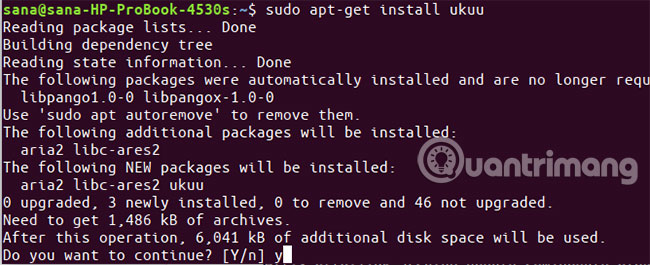
The system can ask you the sudo password and also give you the option Y / N to continue the installation. Enter Y and then press Enter . UKUU will then be installed on the system. However, this process may take a while depending on your Internet speed.
You can verify which version is installed on your system by running the following command:
$ ukuu --version 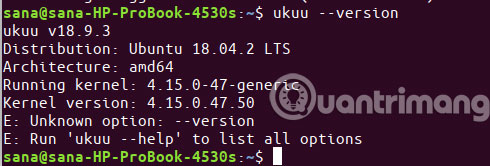
Step 5: Launch UKUU
Now, launch UKUU from Ubuntu's Application Launcher bar as follows or access directly from the application list:
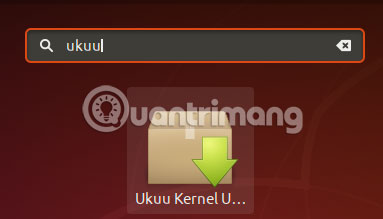
You can also launch it by entering the following command in Terminal:
$ ukuu-gtk When you launch the software, UKUU will start creating a list of all available kernels from the Internet.
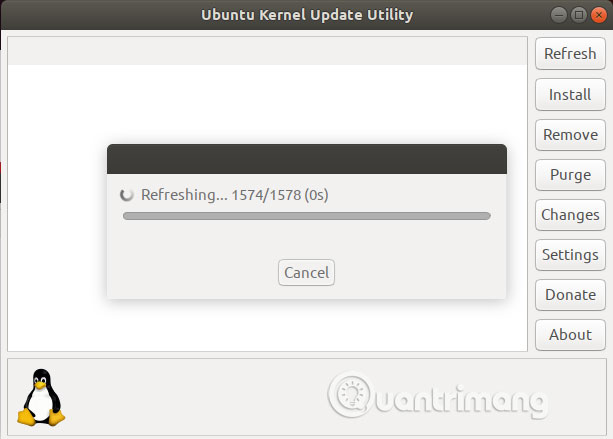
Here's how the list is displayed:

The latest version available, at the time of writing, is Linux 5.0.10. It's best to research a bit about what the kernel you want to upgrade will provide.
Step 6: Install and update to a newer kernel version
Select the kernel version you want to upgrade from the list and then click the Install button . The following authentication dialog box will appear for you to provide authentication details.
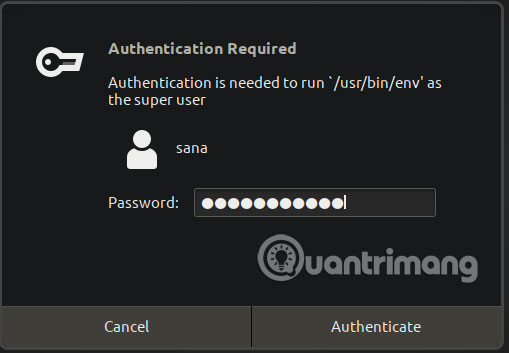
Please note that only authorized users can add / delete and configure software on Ubuntu. Enter the password and click the Authenticate button . The following window opens. You will see the UKUU download and install the selected kernel on your system.

This process may take a while depending on your Internet speed. When the download and installation process is complete, you will be able to see the Close button at the bottom of the window.
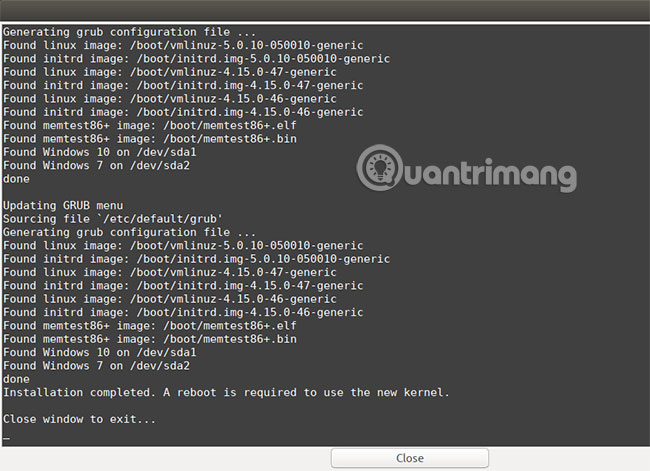
Click the Close button . After that, you can see the following dialog box is displayed:

Please read this information carefully because you may encounter one of the issues mentioned. Click OK after reading, if you encounter any such problems.
Step 7: Reboot the system
Let the new kernel work, restart the system.
Important note : If you have trouble starting or after logging in, you can easily boot from an older kernel. Reboot the system and press Shift when booting, a list will appear. From there you can choose the older kernel version to boot.
Step 8: Verify the current kernel version
Now that you have booted into the newer kernel, run the following command in the Terminal application to verify that the newer version is actually running:
$ uname -r 
Now you are successfully running the new Linux kernel version on Ubuntu!
You should read it
- Linux Kernel 5.16 officially released with great features for gamers
- What's New in Linux Kernel 5.14?
- What's new in Linux Kernel 5.9?
- How to create a Custom Kernel on Ubuntu
- How does the Linux Kernel work?
- How to downgrade kernel in Linux
- Microsoft will release Linux 'genuine' Linux kernel with Windows 10 WSL
- Is Linux the operating system or the kernel?
May be interested
- Canonical releases Ubuntu 21.10 with kernel 5.13 and GNOME 40
 after a long period of internal testing, canonical has officially announced the release of ubuntu 21.10 'impish indri' with many major changes, such as linux kernel 5.13 and gnome 40.
after a long period of internal testing, canonical has officially announced the release of ubuntu 21.10 'impish indri' with many major changes, such as linux kernel 5.13 and gnome 40. - What's new in Ubuntu 18.04? Should update
 the ubuntu 18.04 lts 'bionic beaver' update promises to bring a host of new features to linux computers. if you're wondering what's new in ubuntu 18.04? should i update ubuntu 18.04 or not? the answer will be given to you in tipsmake's article below
the ubuntu 18.04 lts 'bionic beaver' update promises to bring a host of new features to linux computers. if you're wondering what's new in ubuntu 18.04? should i update ubuntu 18.04 or not? the answer will be given to you in tipsmake's article below - How are Linux kernel updates distributed on Windows Update?
 users will be allowed to download linux kernel updates in wsl2 from windows update.
users will be allowed to download linux kernel updates in wsl2 from windows update. - Microsoft will release Linux 'genuine' Linux kernel with Windows 10 WSL
 microsoft will start 'shipping' a built and customized linux kernel (linux kernel), first applied to windows 10 insider builds this summer. it is known that this kernel will act as a backbone of windows subsystem for linux 2.0 or wsl2.
microsoft will start 'shipping' a built and customized linux kernel (linux kernel), first applied to windows 10 insider builds this summer. it is known that this kernel will act as a backbone of windows subsystem for linux 2.0 or wsl2. - Is Linux the operating system or the kernel?
 one of the questions you will probably find on most tech forums is whether linux is the operating system or the kernel. even for some proficient linux users, this question can be relatively difficult to answer.
one of the questions you will probably find on most tech forums is whether linux is the operating system or the kernel. even for some proficient linux users, this question can be relatively difficult to answer. - How to update or downgrade WSL kernel on Windows 11
 if the automatic update fails and you need to change the wsl version for any reason, you can do it manually with the command prompt.
if the automatic update fails and you need to change the wsl version for any reason, you can do it manually with the command prompt. - How to Update Ubuntu Linux
 think your linux is out of date? this article will show you how to update your ubuntu linux system. update your repository list. you can do this by pressing ++. then type in . you will be prompted for your root password. all this command...
think your linux is out of date? this article will show you how to update your ubuntu linux system. update your repository list. you can do this by pressing ++. then type in . you will be prompted for your root password. all this command... - How to troubleshoot Ubuntu problems does not start
 sadly, although linux is very reliable, it sometimes encounters problems, like windows 10 or macos. in most cases, you can solve this problem.
sadly, although linux is very reliable, it sometimes encounters problems, like windows 10 or macos. in most cases, you can solve this problem. - Compare the most popular Linux distributions today
 it can be said that linux is not a complete operating system, it is just a kernel operating system, which is the foundation for developing other operating systems.
it can be said that linux is not a complete operating system, it is just a kernel operating system, which is the foundation for developing other operating systems. - 8 ways Ubuntu changes and improves Linux
 ubuntu is the most prominent linux distribution in the world. ubuntu and its developer, canonical, have been plagued by a lot of fuss over the years, but the linux world is getting much better thanks to both.
ubuntu is the most prominent linux distribution in the world. ubuntu and its developer, canonical, have been plagued by a lot of fuss over the years, but the linux world is getting much better thanks to both.










 10 new features of Linux Ubuntu 19.04
10 new features of Linux Ubuntu 19.04 5 great Linux laptops you can buy now
5 great Linux laptops you can buy now The difference between Ubuntu and Ubuntu-based distributions
The difference between Ubuntu and Ubuntu-based distributions How to install Plex media server on Ubuntu 19.04
How to install Plex media server on Ubuntu 19.04 Compare Debian and Ubuntu
Compare Debian and Ubuntu How to use the vmstat command on Linux
How to use the vmstat command on Linux